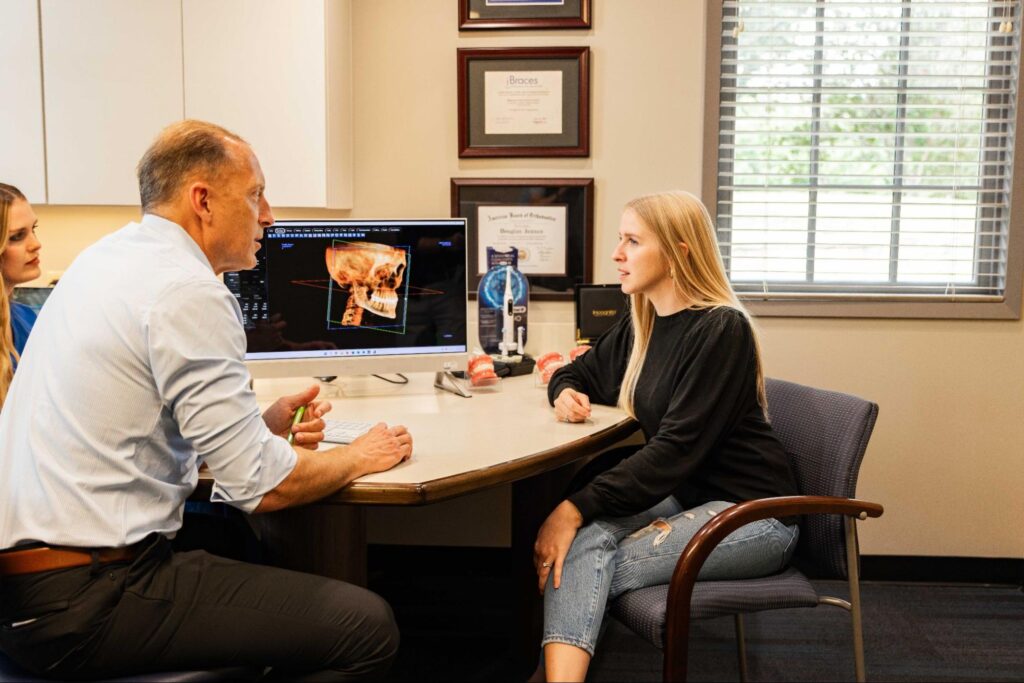Waking up exhausted, no matter how early you went to bed, isn’t something to ignore. Snoring, gasping for air, and frequent headaches in the morning could all be signs of sleep apnea. Many people assume sleep apnea is only treated with CPAP machines, but orthodontic treatment can play a bigger role than most realize.
Jensen Orthodontic Arts in McKinney offers solutions that go beyond straightening teeth. Jaw alignment and airway health are directly connected, and in some cases, orthodontic treatment with Dr. Jensen can help improve sleep apnea symptoms.
What Happens During Sleep Apnea?
Sleep apnea causes breathing to stop repeatedly throughout the night. The most common type, obstructive sleep apnea (OSA), happens when soft tissues in the throat relax too much, blocking airflow. Each time this happens, the brain signals the body to wake up just enough to restart breathing. It can happen dozens of times an hour without you even realizing it. Disrupted sleep from sleep apnea leads to:
- Loud snoring
- Waking up gasping for air
- Headaches in the morning
- Fatigue during the day, no matter how long you sleep
- Brain fog or trouble focusing
- High blood pressure that’s difficult to control
Some people assume snoring means sleep apnea, but that’s not always the case. Others have sleep apnea without ever snoring. A sleep study is the only way to know for sure.
In young children, sleep disordered breathing is particularly detrimental. Waking multiple times during sleep arouses a child and breaks up the sleep patterns, taking them out of deep, restful sleep. This does not allow the brain’s hard drive to “back up” and can lead to slower cognitive development. A child who does not get regular deep sleep will often be misdiagnosed as having ADHD. It has been shown that most kids diagnosed with ADHD actually have some level of sleep apnea instead. Properly treated, symptoms of ADHD and difficulty learning can be solved.
How Orthodontics Can Help with Sleep Apnea
Dr. Jensen and our team work with patients who need solutions beyond CPAP therapy. When jaw alignment is part of the problem, orthodontic treatment can help. Adjusting the position of the teeth and jaw can open the airway, making it easier to breathe. Orthodontics in combination with oral jaw surgery can advance a retruded jaw. Doing this can bring tissues such as the tongue and floor of the mouth forward, out of the airway. This opens the oropharynx, increasing airway volume.
Orthodontic Appliances for Sleep Apnea
CPAP therapy isn’t for everyone. Some people struggle with the mask or can’t tolerate the pressure. Custom-fitted orthodontic appliances can help by keeping the airway open without the bulk of a CPAP machine. Oral appliances are often a good alternative for people with mild to moderate sleep apnea who can’t tolerate a CPAP machine. The type of treatment will depend on your specific circumstances.
Jaw Alignment and Its Role in Sleep Apnea
Certain bite and jaw alignment issues can make sleep apnea worse. When the airway is already small, even minor obstructions can have a big impact. In children, early assessment by an orthodontist and treatment if necessary can prevent learning problems and symptoms of being “overtired”.
Overbite and a Restricted Airway
A deep overbite can nudge the lower jaw backward, leaving little room for airflow. The smaller the airway, the greater the chance of breathing interruptions during sleep.
Crowding and a Small Jaw
A narrow jaw creates less space for the tongue. If the tongue has nowhere to rest properly, it’s more likely to fall back and block the airway. Jaw expansion through orthodontic treatment can help create more room. In kids as young as 7 years old, the palate can be expanded to increase room for erupting teeth and encourage nasal breathing by widening the maxilla and nasal passageways.
TMJ and Sleep Apnea
Issues with the temporomandibular joint (TMJ) can contribute to sleep apnea. When the jaw is misaligned, it can shift backward and make breathing more difficult. Orthodontic treatment can help reposition the jaw, improving both TMJ symptoms of pain and airflow.
Is Orthodontic Treatment Right for You?
The first step in treating sleep apnea is getting a diagnosis. A sleep study will confirm whether sleep apnea is the problem and how severe it is. If jaw positioning is a factor, orthodontic treatment could help improve your symptoms. Consider an orthodontic evaluation if:
- You or your child has a noticeable overbite or recessed lower jaw
- You or your child has a narrow or high palate.
- Very crowded teeth, which could be narrowing your airway
- You experience TMJ pain and suspect it’s affecting your sleep
- You’ve tried a CPAP machine but can’t tolerate it
Some people see the best results with a combination of treatments at Jensen Orthodontic Arts. Jaw positioning, oral appliances, and other lifestyle adjustments can all play a role in improving sleep quality.
Small Changes That Can Help Sleep Apnea Symptoms
Even with the right treatment, certain habits can make a difference:
- Sleep on your side instead of your back. Lying on your back makes it easier for soft tissues to collapse into the airway.
- Elevate your head slightly while sleeping to help keep the airway open.
- Avoid alcohol before bed, since it relaxes throat muscles and makes symptoms worse.
- Keep allergies under control to prevent nasal congestion from making breathing harder.
- Maintain a healthy weight, as excess fat around the neck can increase airway restriction.
Find Out If Orthodontic Treatment Could Improve Your Sleep
Sleep apnea can affect long-term health. If a CPAP machine isn’t working for you or you’re looking for another approach, an orthodontic consultation could be the next step. Jensen Orthodontic Arts offers treatment options that do more than straighten teeth. Schedule an appointment with Dr. Jensen at our McKinney office to find out if an oral appliance could help you sleep better.


